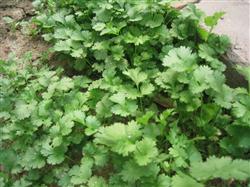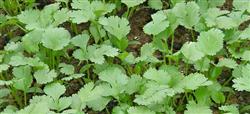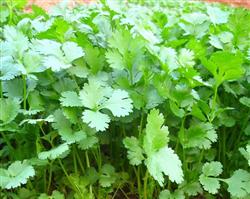How can summer coriander grow with high yield?

How can summer coriander grow with high yield? Please give instructions that coriander likes cold and cool. If the temperature is higher than 20 ℃, it will grow slowly, and if it is higher than 30 ℃, it will stop growing. Therefore, it is difficult to cultivate coriander in summer, and the following cultivation techniques must be grasped. 1. Varieties with drought tolerance, fast growth and late bolting should be selected, such as purple stem coriander, Beijing coriander, North China leaves, American parsley, Thai heat-resistant parsley and so on. Second, the temperature of the seed treatment is high in summer, and the water in the soil evaporates fast. in order to emerge early and the whole seedling, the seeds should be treated carefully before sowing, that is, crushing the pericarp first, and then soaking the seeds to promote germination. Soak the seeds in cold water for 4-5 hours, put the seeds in a cloth bag and hang it 30 cm above the water surface of the well. Soak the cloth bag in water once a day to replenish water. After 7-10 days, the seeds are exposed and sowed. Third, soil preparation and fertilization should choose the soil with fertile soil, water and fertilizer conservation, convenient drainage and irrigation, good ventilation and unplanted coriander for more than 3 years. Apply 4000 kilograms of cow dung per mu, turn the land 2025cm deep, break the clods and rake the land to make a flat bed with a width of 1m and a width of 1.5m and a length of 7m. Fourth, it is best to sow seeds carefully, with a seed consumption of 3 kg per mu. Before sowing, pour enough bottom water in the border. After the water seeps, mix the seeds with sand, sow evenly, and cover 1cm to 2cm thick fine soil. After all the broadcast, there will be a suppression to conserve soil moisture. After sowing, pat the fruit, cover with grass to moisturize, and help the seedlings to be unearthed. The next day, depending on the soil moisture, water was watered once in the morning and once in the evening. In the future, pay attention to keep the soil moist until emergence. The seedlings emerged about 7 days after sowing, and the mulch should be removed when most of the seedlings were unearthed. Fifth, after the emergence of the seedlings, build a small arch shed with a height of 60cm to 70cm, which is covered with a sunshade net to prevent the sun from being exposed to the sun and washed by Rain Water, and remove the sunshade net in the evening to facilitate ventilation. Plant growth is slow in the early stage, the principles of fertilizer and water management are: no drought, less watering in the early stage, more watering in the later stage; the amount of topdressing depends on the soil fertility, mainly nitrogen fertilizer (human and animal manure, urea). Coriander seedlings grow slowly and are prone to "grass barren seedlings", so weeds should be weeded in time. 6. the occurrence of insect pests in summer sown parsley is less, and the main diseases are seedling quenching disease, adult plant virus disease, anthracnose and spot blight and so on. About 5 days after emergence, spray 1 time with 800 times liquid of 3% polyoxane wettable powder, and then spray 600 times liquid every 7 days for a total of 2 times 3 times, which can prevent quenching disease, anthracnose and spot blight; shade can be used to avoid high temperature production reduction; insect prevention net and 20 g imidacloprid wettable powder 20 grams are sprayed on 50 kg water leaves to control aphids in order to reduce the occurrence of virus disease. Click to get more coriander planting techniques click to get more vegetable planting techniques
- Prev

How to grow cilantro well in summer?
How to grow cilantro well in summer? Please give instructions to grow good cilantro in summer can refer to the following methods: 1. Varieties are selected with heat resistance, late bolting and fast growth, such as Beijing coriander, North China leaves and so on. two。 The choice of soil preparation and fertilization is more fertile, water conservation, fertilizer conservation performance is good, drought energy.
- Next

How to manage the cultivation of coriander in open field?
How to manage the cultivation of coriander in open field? Please guide the management methods of open-air cilantro planting can refer to the following: first, the germination period of coriander is longer, it takes about 9-10 days from sowing to emergence. During the sprouting period, if the weather suddenly clears up after rain, it is easy to go up into a layer of "pot cake" in the seedbed, which has a serious impact.
Related
- Where is it suitable to grow horseradish in China? it is expected to see the middle altitude horseradish in Alishan.
- How to prevent tomato virus disease reasonably? (Control methods included)
- Many people like to plant towel gourd on the balcony. What are the main points of this method and management?
- What crops can chili peppers be mixed with?
- Fertilization techniques and matters needing attention in Tomato
- What are the grafting techniques for peach seedlings in spring?
- Harm and control methods of root swelling disease of Chinese cabbage
- What are the pests of sweet potatoes? How to prevent and cure it?
- Symptoms, causes and Control methods of navel Rot in Tomato
- The cause of "Cucumber rotten bibcock" in Farmers' planting Cucumber and its Control Plan

